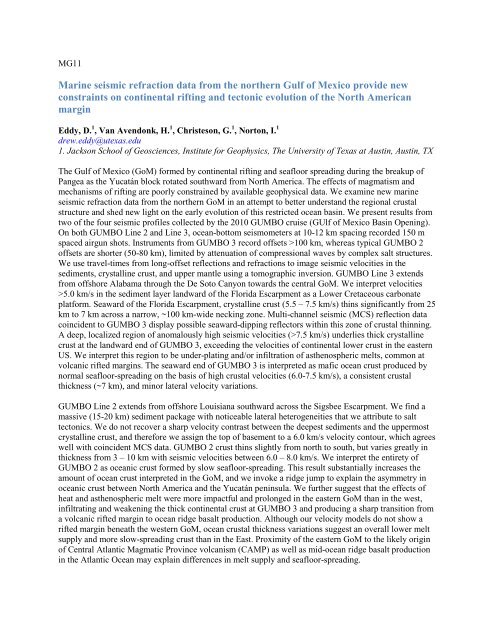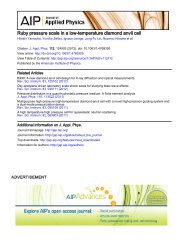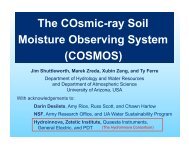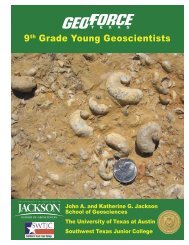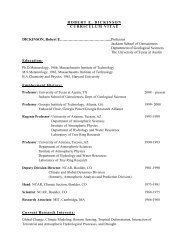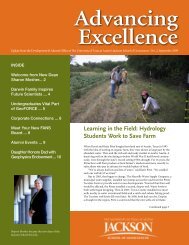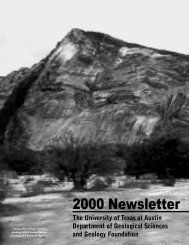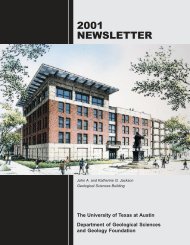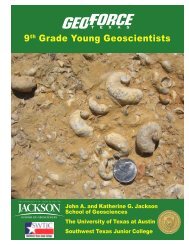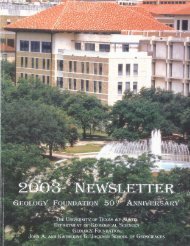Marine seismic refraction data from the northern Gulf of Mexico ...
Marine seismic refraction data from the northern Gulf of Mexico ...
Marine seismic refraction data from the northern Gulf of Mexico ...
Create successful ePaper yourself
Turn your PDF publications into a flip-book with our unique Google optimized e-Paper software.
MG11<br />
<strong>Marine</strong> <strong>seismic</strong> <strong>refraction</strong> <strong>data</strong> <strong>from</strong> <strong>the</strong> nor<strong>the</strong>rn <strong>Gulf</strong> <strong>of</strong> <strong>Mexico</strong> provide new<br />
constraints on continental rifting and tectonic evolution <strong>of</strong> <strong>the</strong> North American<br />
margin<br />
Eddy, D. 1 , Van Avendonk, H. 1 , Christeson, G. 1 , Norton, I. 1<br />
drew.eddy@utexas.edu<br />
1. Jackson School <strong>of</strong> Geosciences, Institute for Geophysics, The University <strong>of</strong> Texas at Austin, Austin, TX<br />
The <strong>Gulf</strong> <strong>of</strong> <strong>Mexico</strong> (GoM) formed by continental rifting and seafloor spreading during <strong>the</strong> breakup <strong>of</strong><br />
Pangea as <strong>the</strong> Yucatán block rotated southward <strong>from</strong> North America. The effects <strong>of</strong> magmatism and<br />
mechanisms <strong>of</strong> rifting are poorly constrained by available geophysical <strong>data</strong>. We examine new marine<br />
<strong>seismic</strong> <strong>refraction</strong> <strong>data</strong> <strong>from</strong> <strong>the</strong> nor<strong>the</strong>rn GoM in an attempt to better understand <strong>the</strong> regional crustal<br />
structure and shed new light on <strong>the</strong> early evolution <strong>of</strong> this restricted ocean basin. We present results <strong>from</strong><br />
two <strong>of</strong> <strong>the</strong> four <strong>seismic</strong> pr<strong>of</strong>iles collected by <strong>the</strong> 2010 GUMBO cruise (GUlf <strong>of</strong> <strong>Mexico</strong> Basin Opening).<br />
On both GUMBO Line 2 and Line 3, ocean-bottom seismometers at 10-12 km spacing recorded 150 m<br />
spaced airgun shots. Instruments <strong>from</strong> GUMBO 3 record <strong>of</strong>fsets >100 km, whereas typical GUMBO 2<br />
<strong>of</strong>fsets are shorter (50-80 km), limited by attenuation <strong>of</strong> compressional waves by complex salt structures.<br />
We use travel-times <strong>from</strong> long-<strong>of</strong>fset reflections and <strong>refraction</strong>s to image <strong>seismic</strong> velocities in <strong>the</strong><br />
sediments, crystalline crust, and upper mantle using a tomographic inversion. GUMBO Line 3 extends<br />
<strong>from</strong> <strong>of</strong>fshore Alabama through <strong>the</strong> De Soto Canyon towards <strong>the</strong> central GoM. We interpret velocities<br />
>5.0 km/s in <strong>the</strong> sediment layer landward <strong>of</strong> <strong>the</strong> Florida Escarpment as a Lower Cretaceous carbonate<br />
platform. Seaward <strong>of</strong> <strong>the</strong> Florida Escarpment, crystalline crust (5.5 – 7.5 km/s) thins significantly <strong>from</strong> 25<br />
km to 7 km across a narrow, ~100 km-wide necking zone. Multi-channel <strong>seismic</strong> (MCS) reflection <strong>data</strong><br />
coincident to GUMBO 3 display possible seaward-dipping reflectors within this zone <strong>of</strong> crustal thinning.<br />
A deep, localized region <strong>of</strong> anomalously high <strong>seismic</strong> velocities (>7.5 km/s) underlies thick crystalline<br />
crust at <strong>the</strong> landward end <strong>of</strong> GUMBO 3, exceeding <strong>the</strong> velocities <strong>of</strong> continental lower crust in <strong>the</strong> eastern<br />
US. We interpret this region to be under-plating and/or infiltration <strong>of</strong> as<strong>the</strong>nospheric melts, common at<br />
volcanic rifted margins. The seaward end <strong>of</strong> GUMBO 3 is interpreted as mafic ocean crust produced by<br />
normal seafloor-spreading on <strong>the</strong> basis <strong>of</strong> high crustal velocities (6.0-7.5 km/s), a consistent crustal<br />
thickness (~7 km), and minor lateral velocity variations.<br />
GUMBO Line 2 extends <strong>from</strong> <strong>of</strong>fshore Louisiana southward across <strong>the</strong> Sigsbee Escarpment. We find a<br />
massive (15-20 km) sediment package with noticeable lateral heterogeneities that we attribute to salt<br />
tectonics. We do not recover a sharp velocity contrast between <strong>the</strong> deepest sediments and <strong>the</strong> uppermost<br />
crystalline crust, and <strong>the</strong>refore we assign <strong>the</strong> top <strong>of</strong> basement to a 6.0 km/s velocity contour, which agrees<br />
well with coincident MCS <strong>data</strong>. GUMBO 2 crust thins slightly <strong>from</strong> north to south, but varies greatly in<br />
thickness <strong>from</strong> 3 – 10 km with <strong>seismic</strong> velocities between 6.0 – 8.0 km/s. We interpret <strong>the</strong> entirety <strong>of</strong><br />
GUMBO 2 as oceanic crust formed by slow seafloor-spreading. This result substantially increases <strong>the</strong><br />
amount <strong>of</strong> ocean crust interpreted in <strong>the</strong> GoM, and we invoke a ridge jump to explain <strong>the</strong> asymmetry in<br />
oceanic crust between North America and <strong>the</strong> Yucatán peninsula. We fur<strong>the</strong>r suggest that <strong>the</strong> effects <strong>of</strong><br />
heat and as<strong>the</strong>nospheric melt were more impactful and prolonged in <strong>the</strong> eastern GoM than in <strong>the</strong> west,<br />
infiltrating and weakening <strong>the</strong> thick continental crust at GUMBO 3 and producing a sharp transition <strong>from</strong><br />
a volcanic rifted margin to ocean ridge basalt production. Although our velocity models do not show a<br />
rifted margin beneath <strong>the</strong> western GoM, ocean crustal thickness variations suggest an overall lower melt<br />
supply and more slow-spreading crust than in <strong>the</strong> East. Proximity <strong>of</strong> <strong>the</strong> eastern GoM to <strong>the</strong> likely origin<br />
<strong>of</strong> Central Atlantic Magmatic Province volcanism (CAMP) as well as mid-ocean ridge basalt production<br />
in <strong>the</strong> Atlantic Ocean may explain differences in melt supply and seafloor-spreading.
Keywords: <strong>Gulf</strong> <strong>of</strong> <strong>Mexico</strong>, continental tectonics, rifting, extension, seafloor-spreading


